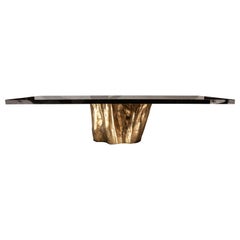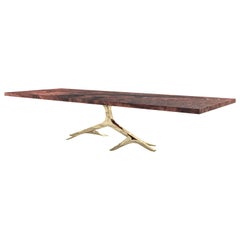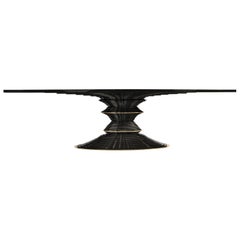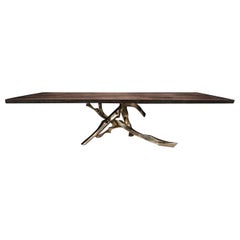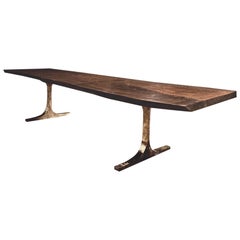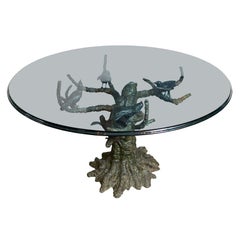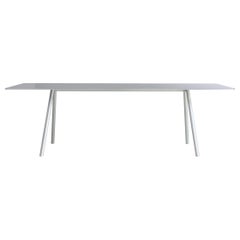Barlas Baylar Dining Room Tables
After finishing his studies in finance and marketing in London and New York, Istanbul-born designer Barlas Baylar established Hudson Furniture in 2004 in Manhattan’s Meatpacking District. Baylar’s reputable firm draws on modern architecture and classic Art Deco design to produce intriguing, complex lighting fixtures and furnishings.
At its New York City atelier, Hudson Furniture’ highly skilled craftspeople create dining tables, chairs and decorative objects by hand, giving each piece its own individual provenance. With respect to sourcing its materials, the company prioritizes conservation (Hudson is a repository for legally harvested petrified wood).
Baylar’s firm utilizes strictly dead or dying wood from around the world, accepting salvaged material and wood from trees downed by storm damage or other natural occurrences, and owing to his love for nature, he seeks to bring the outdoors into interior spaces so that its beauty can be admired as pieces of functional but sculptural furniture.
From the exquisite hand-blown globe glass elements that comprise his Valiant lighting collection to sculptural, striking polished bronze branches that wrap around his Meta credenza, Bayler designs provocative furniture that elevates any space. Over the years Hudson Furniture has partnered with the likes of Tommy Hilfiger, Alexander McQueen, Burberry, Tom Ford and more.
Whether it's a stand-alone coffee table or part of a dining room chair set on display in the firm’s New York City showroom, Hudson Furniture continues to create marvelous, one-of-a-kind pieces to be cherished for generations to come.
2010s European Modern Barlas Baylar Dining Room Tables
Bronze
2010s European Modern Barlas Baylar Dining Room Tables
Bronze, Stainless Steel
2010s North American Barlas Baylar Dining Room Tables
Bronze
2010s European Modern Barlas Baylar Dining Room Tables
Bronze, Stainless Steel
2010s American Barlas Baylar Dining Room Tables
Bronze
2010s American Barlas Baylar Dining Room Tables
Bronze
2010s American Barlas Baylar Dining Room Tables
Bronze
2010s American Barlas Baylar Dining Room Tables
Walnut
2010s American Modern Barlas Baylar Dining Room Tables
Bronze
1970s Italian Vintage Barlas Baylar Dining Room Tables
Bronze
21st Century and Contemporary Japanese Modern Barlas Baylar Dining Room Tables
Aluminum
2010s Brazilian Modern Barlas Baylar Dining Room Tables
Wood
Early 20th Century Hungarian Country Barlas Baylar Dining Room Tables
Pine
1970s Danish Scandinavian Modern Vintage Barlas Baylar Dining Room Tables
Oak
1980s French Modern Vintage Barlas Baylar Dining Room Tables
Iron
1950s American Mid-Century Modern Vintage Barlas Baylar Dining Room Tables
Brass, Metal
1960s American Vintage Barlas Baylar Dining Room Tables
Iron
2010s American Mid-Century Modern Barlas Baylar Dining Room Tables
Walnut
Early 20th Century Industrial Barlas Baylar Dining Room Tables
Metal
1970s American Modern Vintage Barlas Baylar Dining Room Tables
Chrome
20th Century Brazilian Barlas Baylar Dining Room Tables
Wood
